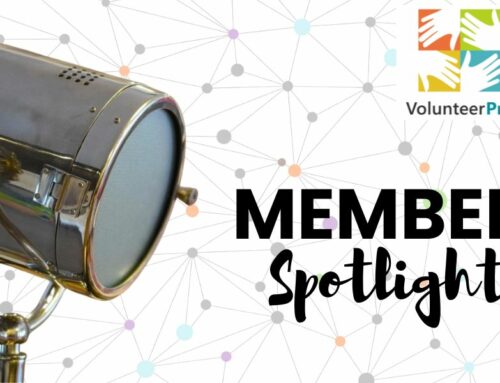Spring Cleaning: How to Refresh Your Volunteer Program Documents
If you are like me, the return of warmer weather (at least in the northern parts of this world!) has you opening your windows wide, blasting 90’s pop hits (is that just me?!), and dusting off the cobwebs that have accumulated over the last year.
Now is also a great time to conduct a quick volunteer program evaluation to ensure your volunteer program documents and materials are primed to inspire and motivate volunteers.
Are your documents dry and boring? They don’t have to be!
In fact, your volunteer program materials are often underestimated, yet powerful opportunities to share expectations, to deepen connections between volunteers and your organization, and to communicate to volunteers the exceptional experience they are about to encounter.
Take this opportunity to refresh the way you present your organization to volunteers and see how these changes can refresh and renew a whole new mood of commitment!
Use Core Volunteer Program Documents to Improve Volunteer Touch Points
Your volunteer program documents aren’t just for show. They serve a purpose! Here are a few ways they can help you out:
- They can collect necessary data
- They can communicate information & values
- They can build & strengthen relationships
- They can inspire action
As a volunteer management professional, you and your team have an incredibly powerful opportunity to change the world, one person at a time.
And, you have the chance to be the architect of your success!
Volunteers interact with your organization several times before they actually join. Don’t waste your volunteer recruitment energy until you have a smooth process in place.
Make sure the journey from outside observer to learner and doer is optimized to be as pleasant and inspirational as possible.
Here are some easy tips to remember:
- Try to keep the language in your documents simple, friendly, and straightforward.
- Avoid jargon and acronyms.
- Also, since volunteer management involves supervising people, your organization’s attorney or human resources staff should do a legal review of any documents you develop.
Read on for a more in-depth look at how you can refresh your volunteer program documents.
Make Volunteer Position Descriptions
More Mission-Focused
Position descriptions are a great place to let volunteers know that the hassle of learning the ropes at your organization is truly worth it.
In them, you can communicate:
- The organization’s clear dependence on, and appreciation for, volunteers through a Philosophy of Volunteer Involvement.
- How your organization is making a difference and how volunteers fit into the larger picture through an Impact Statement.
- What existing volunteers think about their relationship with the organization though personal testimonials. This also helps set expectations and inspire hope.
Below are two things you might include to spice your volunteer position descriptions up and add more meaning and purpose.
Philosophy of Volunteer Involvement
If you don’t have a Philosophy of Volunteer Involvement, this is one of the first steps in developing a rationale for volunteer involvement at your organization.
It should communicate the value of volunteers to your organization, which must be beyond merely saving money. Think about how volunteers might expand and deepen the services your agency offers.
Once your philosophy is developed, you can add it to your position descriptions to spruce them up and encourage deeper involvement and commitment from your volunteers.
Here’s our formula for developing your own Philosophy of Volunteer Involvement:
Importance of Volunteers + Standards/Characteristics
+ Tasks + Results
For Example: “Volunteers are a valued as an essential part of accomplishing the [agency] mission to reach out and deliver [agency] services with compassion and care. Volunteers provide education and information that empowers Medicare recipients to make informed decisions about their health care coverage options, rights, and benefits. Through their unique skills and talents, volunteers augment the work of paid staff and expand our services far beyond our agency doors into new and diverse communities in need.”
Impact Statements
Including your organization’s mission and volunteer program impact statements can create more interest in your position descriptions.
Impact statements reflect the following:
-
- Change in Knowledge
- Change in Behaviors
- Change in Status Quo
To develop impact statements for every volunteer position at your organization, ask these questions:
-
- What do people know now as a result of their involvement in this program/service/etc.?
- What do people now do as a result of their involvement in this program/service/etc.?
- What has changed as a result of this program/service/etc.?
Pique Interest with
Compelling Volunteer Testimonials
Another way you can spice up your volunteer program documents is to add volunteer testimonials.
Volunteer testimonials are one of the most powerful ways to tap into the psychological phenomenon of social proof (or informational social influence). They let the community, and people who may be considering a volunteer opportunity, know that your organization is worthy of support.
When existing volunteers share information about their relationship with your program and what they have achieved, it also helps set expectations and inspire hope in newcomers.
The best time to request a recommendation is after a volunteer has experienced a positive experience with your organization.
Here are a few instances when you might want to make your ask:
- After an achievement Is met (meets a goal, completes a year of service, concludes an in-depth training series, etc.)
- When a volunteer thanks or compliments you, a co-worker, or your agency.
- At celebrations
- During a performance review
- As part of your exit interview
Questions to Ask
Below are some questions that are more likely to prompt a thoughtful and unique response than simply “tell us why you like us.” They will also be more interesting to those who read them. Choose a few that make the most sense at your program and ask them in short interviews or surveys.
- Why does this cause matter?
- Why is this cause important to you?
- What impact does your volunteer role have on the clients or community?
- What happened when you volunteered (or supported this organization)?
- How do you feel about your experience?
- What do you like most about it)?
- What does it like to be a [insert volunteer role]? How has it changed you?
- What would you say to someone might consider volunteering?
- Would you recommend this experience to others? Why?
Once you have a decent bank of testimonials, you can include them on every volunteer position description to prove the value volunteers have at your organization in this role. Also, by including testimonials you reinforce that your organization is truly worthy of a deep commitment.
Spice Up Dry and Boring Volunteer Manuals
Your volunteer manual is a guide to your organization on how volunteers can expect to fit in as a piece of the puzzle. It helps your volunteers locate where they are, see where they are headed, and figure out how long it will take to get there.
Your volunteer manual doesn’t have to be a boring recital of rules, regulations, policies, and procedures. There are ways you can get creative in how you compile your volunteer manuals.
Making Rules & Regulations Palatable
There are three easy ways to encourage volunteer compliance with your policies and procedures:
- Keep Consistent
- Leverage Social Proof
- Emphasize Social Norms
All three tactics are related to how you design and what you include in your core volunteer program documents, including your volunteer manual.
Exposure Effect
The mere exposure effect (or familiarity principle) suggests that we develop greater positive feelings toward a stimulus if we are repeatedly exposed to it. This is because through repeat exposures the new stimulus becomes more familiar and less threatening.
Familiarity does not breed contempt. In fact, it’s just the opposite. Repetition of messages is powerful because it increases processing fluency in the brain. The easier and faster something is to process, the better we feel about it, and we misattribute those good feelings to positivity about the message.
Common graphic elements might include “remember this” wrap-ups at the end of the sections in volunteer manuals, etc.
All volunteer communications platforms — recruitment materials, applications, training materials, manuals, etc. – should have the same look and feel, as well as messaging.
Don’t be afraid to repeat yourself!
Social Proof
People are highly motivated to conform to social norms, and so, the more volunteers feel that the people giving testimonials are like them, the more they will listen up!
Social proof, also known as informational social influence, is a psychological phenomenon where people assume the actions of others in an attempt to reflect correct behavior for a given situation.
Social proof is so powerful that even showing many people doing something wrong can encourage other people to do it more!
Psychologists have found that we are likely to judge a person’s opinion based on our overall impression of him or her, called the “halo effect.” Since influencers already have an established reputation, anything else they involve themselves with is seen in a better light by association. This is why a testimonial from an influential person is one of the few alternatives that can help you boost the effectiveness of your social proof.
Normative Influence
Normative influence is the pressure to conform to avoid negative social consequences or rejection.
Here are some ways you can use normative influence in your volunteer program:
- Communicate that most volunteers are following guidelines: Instead of nagging, report how many people are compliant. For example, get more volunteers to track their hours by stating something like “96% of volunteers turn in their timesheets every month”.
- “Seed” volunteer sign-in or sign-up sheets: include the ideal number of hours or shifts (or show as examples in the volunteer manual or training).
- Have volunteers deliver training on compliance: And make sure they have a say in new policies that are being formed and/or changed.
- Use the norm of reciprocity in your favor: Find ways to compliment volunteers regularly, including in writing. They will reciprocate by doing what they may consider “favors” for you.
What Else Should You Update?
Below are some core volunteer program documents we haven’t discussed yet that you can update in a way that will help you build and strengthen your relationships with volunteers.
- Your job description: Did you know you should update your job description annually?! This year, update your description to allow for an adequate amount of time for relationship building with all stakeholders.
- Your business card: Include an inspirational quote or philosophy of volunteer involvement on back of card.
- Volunteer application: Applications don’t have to be all about the vital information you are gathering! This is a great place to start showing your volunteers that your organization prioritizes the interests, safety, and wellbeing of everyone. This spring is a great time to re-vamp your volunteer application to ensure you are using inclusive language.
- Volunteer screening interview questions: With the right questions, you can learn about volunteer’s preferences and how they will behave in certain situations. Audit your current screening process. Are you talking more than you are listening? If so, it’s time to consider if you are asking the right questions.
- Volunteer agreement: A well-designed volunteer agreement reassures new volunteers that your organization is well-run and that their time and talent is valuable and protected. Include statements on privacy, confidentiality, conflicts of interests, and more in your agreements to start your relationship with new volunteers on the right foot.
Are you considering any spring cleaning in your volunteer program? Join the VolunteerPro Insiders Community on Facebook and tell us about your experience!







